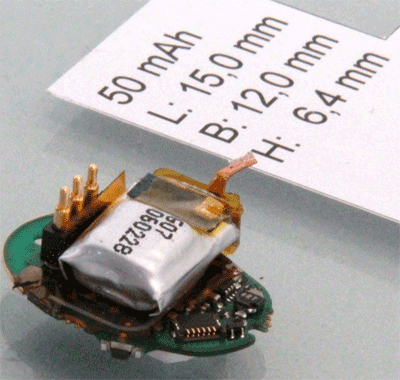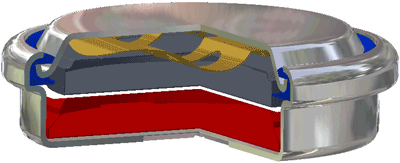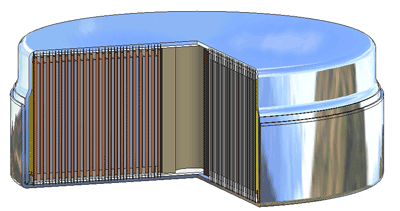Innovations in rechargeable battery construction
New construction techniques enable higher energy density for miniature electronic devices
BY ROBERT HIEBER
Senior Product Manager
VARTA Microbattery
www.varta-microbattery.com
The electronics industry’s genius for miniaturization is famous. Shrinkage has been achieved most obviously at the level of the transistor. But ingenuity has also been applied to other elements of electronics systems: in wireless and portable devices, for instance, today’s battery designs provide high energy capacity in often surprisingly small packages.
Indeed, the battery designs of miniature portable devices, such as wireless Bluetooth headsets, are marvels of engineering in their own way (see Fig. 1 ). Through the use of complex device-specific optimizations and customized packages, engineers have been able to build adequate energy capacity into form factors small enough — in the case of a headset — to be used in earphones, even when working within the limitations of conventional lithium-ion battery technology.
But as Fig. 1 shows, these optimization efforts require the implementation of complex packages which must be assembled by hand, and which require their own protection circuit mounted on or alongside the battery pouch.

Fig. 1: Typical example of a miniature rechargeable battery pack. T — this one is used in a Motorola wireless (Bluetooth) headset.
In the kinds of applications which use these battery packs, any reduction in size and complexity is highly valued. This article introduces a new rechargeable battery design which offers higher energy density in a more robust package which is easier to assemble. Available as a standard part, it looks set to mount a stiff challenge to today’s highly specialised, custom-engineered lithium battery packs.
Implementing mini-rechargeable batteries
Miniature wireless devices used in consumer, medical and security applications today typically implement rechargeable lithium technology. (Using a rechargeable, rather than a primary, battery means that the device can remain permanently sealed — an essential feature of devices operating in regulated medical and security markets.)
Lithium cells offer higher energy density than other rechargeable chemistries such as nickel metal hydride (NiMH), while providing a high enough output voltage — typically 3.7 V — to support typical circuit requirements.
In devices such as headsets, the basic design constraint on the battery is the requirement to provide an energy capacity of around 50mAh while being small and light enough to be worn in or near the ear. Previous generations of standard lithium coin cells did not offer sufficient energy density — a cell of the required energy capacity was too large.
Consequently, headset manufacturers have implemented custom battery packs which maximize energy capacity by defining a unique package outline and profile tailored to fit the device’s casing, and therefore to provide the maximum possible battery volume in the available space.
This approach has enabled device manufacturers to meet minimum goals for energy capacity, and therefore for operating time between charges. But it also entails trade-offs: in order to keep unit costs within a viable range, custom lithium batteries are typically packaged in a soft pouch or sleeve, because these are cheap to produce. But this soft material is vulnerable to damage during production, and must be assembled manually.
Additionally, custom lithium packs require a dedicated control and protection circuit to regulate the charging process and to protect the cell from excessive currents, voltages and temperature. This custom circuit is normally mounted on top of or alongside the pouch, adding to the space taken up by the battery. And the design of the custom circuit adds cost and time to the product development process.
Finally, a custom part, unique to one customer, carries a higher supply-chain risk for the customer than a standard part, which is produced and stocked in high volume for multiple customers.
How manufacturers use standard coin cells today
So are standard cells a viable design option for manufacturers of small devices? Coin cells are the electronics industry’s favoured type of standard battery in small form factor designs (see Fig. 2 ). Coin cells have many advantages:
They have a hard metal casing which protects the cell from knocks and scratches during the assembly process and in the end user equipmentThey retain their shape and size under normal operating conditions. The metal casing shows negligible levels of expansion and contraction as the temperature in the cell rises and falls. By contrast, the soft packaging of custom lithium battery packs swells markedly in use. They are easy to assemble using automated equipmentThey have a circular footprint, which is useful in devices such as earphones and headsets which have a naturally circular outline.

Fig. 2: A conventional rechargeable lithium coin cell.
However, in previous generations of rechargeable lithium coin cells, the internal structure of the cell, using either stacked or layered electrodes, restricted the energy density to a low level. The footprint of the batteries is also extended by the pronounced lip visible in Fig. 2, which in conventional production processes is required to seal the battery robustly.
So for manufacturers of small, portable devices requiring energy capacity in the range 40 to 100 mAh, the size, weight and footprint of standard lithium coin cells has been too large.
Innovations in Li coin-cell construction
Device manufacturers ideally want a smaller, lighter standard cell with high energy density. In the absence of such an ideal product, manufacturers have been reaching their energy capacity target through the use of custom lithium cells which are prone to damage, unsuitable for automated assembly and occupy a relatively large volume.
Now, however, innovations in the construction of lithium coin cells have increased their energy density to the point at which standard coin cells can replace custom battery packs. These innovations developed by VARTA Microbattery have been implemented in a family of batteries called “coin power.” The first two devices in the range provide a combination of small size and high capacity, which is ideal for applications such as Bluetooth headsets, access control tags, and personal medical devices.
The cells feature a new coiled-electrode construction that makes far more efficient use of the space inside the casing, accommodating a greater surface area of electrode per cubic centimeter than conventional stacked-electrode or layered-electrode construction. In order to implement this new coiled-electrode construction, VARTA has implemented advanced coil winding technology that precisely controls the position of the electrodes inside the cell casing.
VARTA has also invented a patented “ILoc” casing construction. The precisely-engineered upper and lower casings slide together securely, eliminating the requirement for a bulky rim and separate sealing material (see Fig. 3 ). Moreover, this ILoc design also enables the cell to operate as a current-interruption device: When the pressure inside the cell rises above a certain level — as happens when the cell is charged at an excessive current or voltage — the upper and lower casings come apart by a small, controlled amount sufficient to break the circuit and shut down the battery.


Fig. 3: conventional coin cell construction (3a) and VARTA’s patented ILoc cell construction (3b) as used in the new Coin Power batteries.
While the Coin Power battery’s electrode design plays a crucial part in producing a cell with a high energy density, it is also important to note that the supporting electronic circuit is also small. The cell requires only a standard circuit protection IC, available at very low cost from suppliers such as Seiko and Mitsumi, plus two miniature passive components. Any of a wide range of standard battery charger ICs can be used to control the cell’s charging process. The footprint of this circuitry is considerably smaller than the complex PCB generally implemented in custom battery packs.
Additionally, since the Coin Power battery (see Fig. 3b) is a standard part, and the supporting circuitry can easily be implemented using standard components, device manufacturers can now avoid the design and production cost and risk associated with the use of custom engineered battery packs, while satisfying their requirement for high energy capacity in a small footprint.
At the same time, they benefit from the use of a robust battery with a hard metal case that can be assembled using automated equipment, thus lowering production costs and eliminating the risk of manufacturing defects attributable to the manual production processes typically used in the assembly of custom battery packs.
Lightweight wearable technology
The sweet spot for these first parts is expected to be in Bluetooth and other wireless headsets, as well as certain personal health and security devices. As the family of devices expands, however, it is expected that these batteries will enable new “wearable” technologies, providing a power source that can be sewn into clothing or embedded in small electronic devices worn on the wrist or around the neck. ■
Advertisement
Learn more about Varta Batteries





